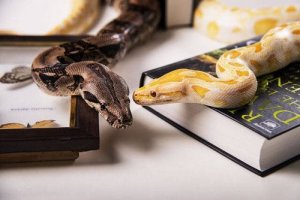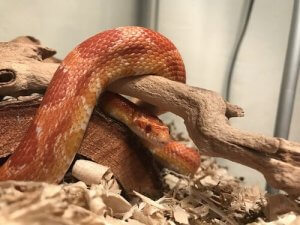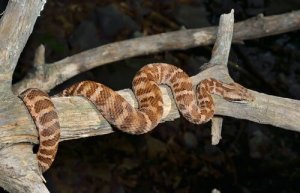Exotic Pets - Types of Domestic Snake


Written and verified by the lawyer Francisco María García
Before you start trying to decide which types of domestic snake you’d like to own, it’s important to make sure that you’re actually allowed to keep them in captivity. If you take a look online, you’ll find a detailed list of all the exotic species considered illegal in your country.
Owning certain kinds of reptiles is considered a crime, as it can help to finance illegal wildlife trafficking. In many countries, it’s also illegal to breed any animals at risk of extinction, no matter what the species.
If you’re thinking about buying an exotic pet, you need to be able to verify where that animal has come from, and choose your supplier carefully. Don’t buy from individuals, or unlicensed pet stores, as there’s a high risk of inadvertently buying from black market traders.
How to choose a domestic snake
1. Size and space
Snakes come in a range of different sizes. While some can measure over 30 ft, others measure no more than a few inches.

It’s important to choose a species that’s suitable for the size of your home. It’s also worth remembering that an animal can quickly develop health and behavioral problems if kept in an unsuitable environment.
2. Diet
Many snakes live on a diet of mice or small mammals in the wild. This can make it more difficult to provide them with the right diet in captivity.
We would recommend choosing domestic snakes that feed on a diet of insects, crustaceans, fish or snails. This diet is much easier to deal with, and these items are often sold fresh in pet stores.
3. Sociability
Some snake species are more sociable than others, and find it easier to adapt to family life. Many people actually choose to buy them as children’s pets.
Some species of snake can even be trained to do tricks and play with their owners.
4. Venomous snakes are prohibited
There are several species of wild and venomous snake that are prohibited by law in many countries around the world. When kept in captivity, these snakes can pose a serious risk to owners and other pets.
The same goes for wild constrictors, which can become aggressive if not given adequate care.
5. Children and domestic snakes
Having a child in the house is a deciding factor when it comes to choosing a pet. This also applies to snakes.
Many children are curious about the idea of keeping a snake as a pet. If you agree to let them have one, it’s best to choose smaller species, which are easier to train, handle and socialize.
What are the most common types of domestic snake
In this next section, we’ll show you the domestic snakes that adapt best to life in captivity.
Types of domestic snake: children and beginners
We would recommend starting with the species that are easiest to handle, and require the most basic level of care.
- Corn snake: this is the most popular species of domestic snake. Docile and easy to train, they grow to roughly 3 ft in length, and are orange, red and black in color. Corn snakes mainly feed on a diet of crickets, rodents, lizards and worms.
- The Indian python: though they are easy to handle and require very little care, Indian pythons require a large outdoor vivarium and plenty of water in order to live comfortably. They are fairly sociable around people and other snakes. On average, they measure roughly 16 ft in length.
- Royal python: while they are similar to the Indian python, royal pythons measure 3-6.5 ft in length. Their array of bright colors makes them a particularly attractive species. They are also easy to handle, require little space, and are normally very docile. Royal pythons are also known as ball pythons, due to their habit of curling into a ball when stressed or frightened.
- Milk snake: of all the domestic snakes, this is one of the best. They usually measure between 1.6 and 5 ft in length, making them really easy to handle. They come in a range of attractive red, black, and yellow tones, and their diet mainly consists of insects, frogs, fish, and small crustaceans.

Domestic snakes: experienced snake owners
- Rat snakes: there are several different types of rat snake. Many of them are non-venomous, and can be kept in captivity. They have beautiful brown and orange scales, and usually measure between 5 and 6.5 ft. They’ll also need access to plenty of fresh water, as they like to bathe regularly.
- Boa constrictor: there is a great deal of controversy around the subject of keeping boa constrictors in captivity. Many people argue that they are extremely docile snakes, and are fairly easy to train. They don’t need a high level of care, and rarely become aggressive when socializing.
Every type of domestic snake requires a certain level of knowledge and preparation on the part of its owner. Responsible ownership is essential for ensuring they live a long and happy life.
Before you start trying to decide which types of domestic snake you’d like to own, it’s important to make sure that you’re actually allowed to keep them in captivity. If you take a look online, you’ll find a detailed list of all the exotic species considered illegal in your country.
Owning certain kinds of reptiles is considered a crime, as it can help to finance illegal wildlife trafficking. In many countries, it’s also illegal to breed any animals at risk of extinction, no matter what the species.
If you’re thinking about buying an exotic pet, you need to be able to verify where that animal has come from, and choose your supplier carefully. Don’t buy from individuals, or unlicensed pet stores, as there’s a high risk of inadvertently buying from black market traders.
How to choose a domestic snake
1. Size and space
Snakes come in a range of different sizes. While some can measure over 30 ft, others measure no more than a few inches.

It’s important to choose a species that’s suitable for the size of your home. It’s also worth remembering that an animal can quickly develop health and behavioral problems if kept in an unsuitable environment.
2. Diet
Many snakes live on a diet of mice or small mammals in the wild. This can make it more difficult to provide them with the right diet in captivity.
We would recommend choosing domestic snakes that feed on a diet of insects, crustaceans, fish or snails. This diet is much easier to deal with, and these items are often sold fresh in pet stores.
3. Sociability
Some snake species are more sociable than others, and find it easier to adapt to family life. Many people actually choose to buy them as children’s pets.
Some species of snake can even be trained to do tricks and play with their owners.
4. Venomous snakes are prohibited
There are several species of wild and venomous snake that are prohibited by law in many countries around the world. When kept in captivity, these snakes can pose a serious risk to owners and other pets.
The same goes for wild constrictors, which can become aggressive if not given adequate care.
5. Children and domestic snakes
Having a child in the house is a deciding factor when it comes to choosing a pet. This also applies to snakes.
Many children are curious about the idea of keeping a snake as a pet. If you agree to let them have one, it’s best to choose smaller species, which are easier to train, handle and socialize.
What are the most common types of domestic snake
In this next section, we’ll show you the domestic snakes that adapt best to life in captivity.
Types of domestic snake: children and beginners
We would recommend starting with the species that are easiest to handle, and require the most basic level of care.
- Corn snake: this is the most popular species of domestic snake. Docile and easy to train, they grow to roughly 3 ft in length, and are orange, red and black in color. Corn snakes mainly feed on a diet of crickets, rodents, lizards and worms.
- The Indian python: though they are easy to handle and require very little care, Indian pythons require a large outdoor vivarium and plenty of water in order to live comfortably. They are fairly sociable around people and other snakes. On average, they measure roughly 16 ft in length.
- Royal python: while they are similar to the Indian python, royal pythons measure 3-6.5 ft in length. Their array of bright colors makes them a particularly attractive species. They are also easy to handle, require little space, and are normally very docile. Royal pythons are also known as ball pythons, due to their habit of curling into a ball when stressed or frightened.
- Milk snake: of all the domestic snakes, this is one of the best. They usually measure between 1.6 and 5 ft in length, making them really easy to handle. They come in a range of attractive red, black, and yellow tones, and their diet mainly consists of insects, frogs, fish, and small crustaceans.

Domestic snakes: experienced snake owners
- Rat snakes: there are several different types of rat snake. Many of them are non-venomous, and can be kept in captivity. They have beautiful brown and orange scales, and usually measure between 5 and 6.5 ft. They’ll also need access to plenty of fresh water, as they like to bathe regularly.
- Boa constrictor: there is a great deal of controversy around the subject of keeping boa constrictors in captivity. Many people argue that they are extremely docile snakes, and are fairly easy to train. They don’t need a high level of care, and rarely become aggressive when socializing.
Every type of domestic snake requires a certain level of knowledge and preparation on the part of its owner. Responsible ownership is essential for ensuring they live a long and happy life.
All cited sources were thoroughly reviewed by our team to ensure their quality, reliability, currency, and validity. The bibliography of this article was considered reliable and of academic or scientific accuracy.
- Bates, M. F., & Little, I. T. (2013). Predation on the eggs of ground-nesting birds by Dasypeltis scabra (Linnaeus, 1758) in the moist highland grasslands of South Africa. African Journal of Herpetology, 62(2), 125-134. https://journals.co.za/doi/abs/10.1080/21564574.2013.786760
- Enloe, E., Bartek, B., Doody, S., Gray, C., Kimes, K., Clulow., S., Deering, S., Fryer, H., Soennichsen, K., & Webster, G., (2020). Antaresia Childrini (Childrens’s Python). Diet. Herpetological Review, 51(2), 339. https://www.researchgate.net/publication/342599964_Antaresia_Childreni_Children’s_Python_Diet
- Florida Museum. (2021). Florida snake id guide. Responsible snake ownership. Consultado el 04 de mayo de 2023. https://www.floridamuseum.ufl.edu/florida-snake-id/responsible-snake-ownership/
- Greater Los Angeles Zoo Association. (2023). Rosy Boa. Lichanura trivirgata. Consultado el 04 de mayo de 2023. https://lazoo.org/explore-your-zoo/our-animals/reptiles/rosy-boa/
- Isberg, T. (2002). Lampropeltis triangulum. Scarlet kingsnake. Animal Diversity Wen. Consultado el 04 de mayo de 2023. https://animaldiversity.org/accounts/Lampropeltis_triangulum/
- Kusrini, M., Palesa, S. P., & Masy’ud, B. (2021). Snake pet ownership in the city: A case study in Greater Jakarta, Indonesia. Biodiversitas Journal of Biological Diversity, 22(4). https://smujo.id/biodiv/article/view/8144
- Meer, J. (1995). The care and breeding of Thamnophis species. Literatura Serpemtium, 15(3), 64-69. https://www.snakesociety.nl/jaargangen/1995e/Litteratura%20Serpentium%2015-3%20064-069%20vhMeer,%20The%20care%20and%20breeding%20of%20Thamnophis%20species.pdf
- Mitchell, M. A. (2004). Snake care and husbandry. Veterinary Clinics of North America: Exotic Animal Practice, 7(2), 421-446. https://www.sciencedirect.com/science/article/abs/pii/S1094919404000131?via%3Dihub
- Organización Mundial de la Salud. (17 de mayo 2021). Mordeduras de serpientes venenosas. Consultado el 1 de junio de 2023. https://www.who.int/es/news-room/fact-sheets/detail/snakebite-envenoming
- Raiti, P. (1995). Captive Care of the Common Kingsnake, Lampropeltis getula. https://meridian.allenpress.com/jhms/article/5/1/9/426271/Captive-Care-of-the-Common-Kingsnake-Lampropeltis
- Royal Society for the Prevention of Cruelty to Animals. (2023). Corn snake care. Consultado el 04 de mayo de 2023. https://www.rspca.org.uk/adviceandwelfare/pets/other/cornsnake
- Royal Society for the Prevention of Cruelty to Animals. (2023). Keeping a royal python as a pet. Consultado el 04 de mayo de 2023. https://www.rspca.org.uk/adviceandwelfare/pets/other/royalpython
- Sanyal, D., Douglas, T., & Roberts, R. (1997). Salmonella infection acquired from reptilian pets. Archives of disease in childhood, 77(4), 345-346. https://www.ncbi.nlm.nih.gov/pmc/articles/PMC1717353/pdf/v077p00345.pdf
- Schroter, M., Speicher, A., Hofmann, J., & Roggentin, P. (2006). Analysis of the transmission of Salmonella spp. through generations of pet snakes. Environmental Microbiology, 8(3), 556-559. https://ami-journals.onlinelibrary.wiley.com/doi/abs/10.1111/j.1462-2920.2005.00934.x
- Suárez, B. (2004). La boa constrictor como animal doméstico. Revista AMMVEPE, 15(2), 61-64. https://www.imbiomed.com.mx/articulo.php?id=22534
- The Maryland Zoo in Baltimore. (2023). Python molurus Indian python. Consultado el 04demayo de 2023. https://www.marylandzoo.org/animal/indian-python/
- Trepanowski, P. (2003). Pantherophis obsoletus. Animal Diversity Web. Consultado el 04 de mayo de 2023. https://animaldiversity.org/accounts/Pantherophis_obsoletus/
This text is provided for informational purposes only and does not replace consultation with a professional. If in doubt, consult your specialist.








